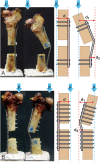Effect of plate working length on plate stiffness and cyclic fatigue life in a cadaveric femoral fracture gap model stabilized with a 12-hole 2.4 mm locking compression plate
- PMID: 23800317
- PMCID: PMC3704939
- DOI: 10.1186/1746-6148-9-125
Effect of plate working length on plate stiffness and cyclic fatigue life in a cadaveric femoral fracture gap model stabilized with a 12-hole 2.4 mm locking compression plate
Abstract
Background: There are several factors that can affect the fatigue life of a bone plate, including the mechanical properties of the plate and the complexity of the fracture. The position of the screws can influence construct stiffness, plate strain and cyclic fatigue of the implants. Studies have not investigated these variables in implants utilized for long bone fracture fixation in dogs and cats. The purpose of the present study was to evaluate the effect of plate working length on construct stiffness, gap motion and resistance to cyclic fatigue of dog femora with a simulated fracture gap stabilized using a 12-hole 2.4 mm locking compression plates (LCP). Femora were plated with 12-hole 2.4 mm LCP using 2 screws per fracture segment (long working length group) or with 12-hole 2.4 mm LCP using 5 screws per fracture segment (a short working length group).
Results: Construct stiffness did not differ significantly between stabilization techniques. Implant failure did not occur in any of the plated femora during cycling. Mean ± SD yield load at failure in the short plate working length group was significantly higher than in the long plate working length group.
Conclusion: In a femoral fracture gap model stabilized with a 2.4 mm LCP applied in contact with the bone, plate working length had no effect on stiffness, gap motion and resistance to fatigue. The short plate working length constructs failed at higher loads; however, yield loads for both the short and long plate working length constructs were within physiologic range.
Figures



References
-
- Gautier E, Sommer C. Guidelines for the clinical application of the LCP. Injury. 2003;34(Supplement 2):63–76. - PubMed
-
- Miller DL, Goswami T. A review of locking compression plate biomechanics and their advantages as internal fixators in fracture healing. Clin Biomech. 2007;22(10):1049–1062. - PubMed
-
- Tornkvist H, Hearn TC, Schatzker J. The strength of plate fixation in relation to the number and spacing of bone screws. J Orthop Trauma. 1996;10(3):204–208. - PubMed
-
- Sanders R, Haidukewych GJ, Milne T, Dennis J, Latta LL. Minimal versus maximal plate fixation techniques of the ulna: the biomechanical effect of number of screws and plate length. J Orthop Trauma. 2002;16(3):166–171. - PubMed
-
- Hoffmeier KL, Hofmann GO, Mückley T. Choosing a proper working length can improve the lifespan of locked plates: a biomechanical study. Clin Biomech. 2011;26(4):405–409. - PubMed
MeSH terms
LinkOut - more resources
Full Text Sources
Other Literature Sources
Medical
Miscellaneous

